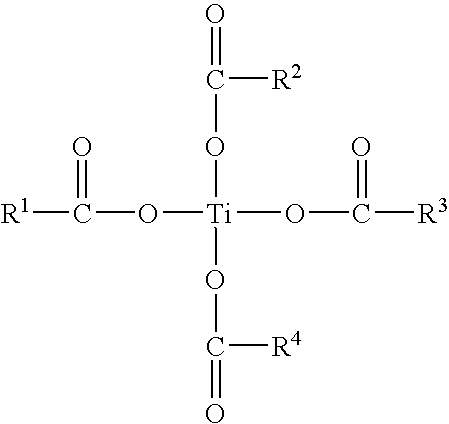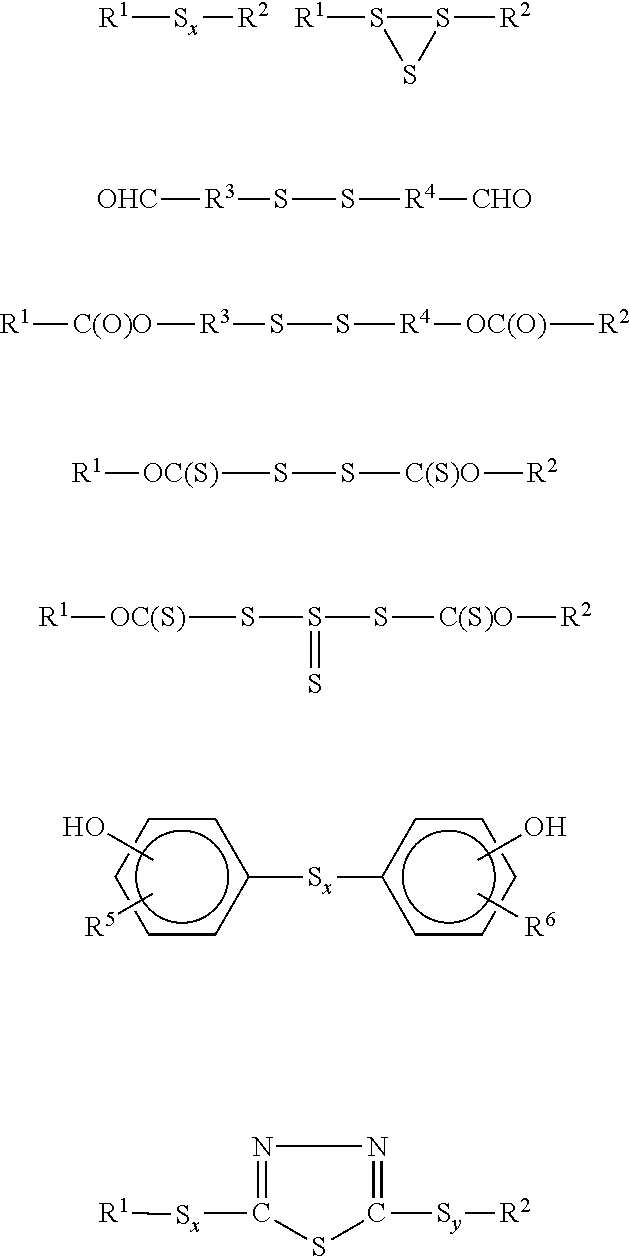Titanium-containing lubricating oil composition
a technology of lubricating oil and titanium, which is applied in the direction of non-fuel substance addition to fuel, machines/engines, mechanical instruments, etc., can solve the problems of adverse effects on other characteristics, high price of molybdenum compounds relative to more conventional, metal-free (ashless) organic friction modifiers, etc., to improve lubricant properties, reduce sludge, and reduce surface wear
- Summary
- Abstract
- Description
- Claims
- Application Information
AI Technical Summary
Benefits of technology
Problems solved by technology
Method used
Image
Examples
example 1
Synthesis of Titanium Neodecanoate
[0027]Neodecanoic acid (about 600 grams) was placed into a reaction vessel equipped with a condenser Dean-Stark trap, thermometer, thermocouple, and a gas inlet. Nitrogen gas was bubbled into the acid. Titanium isopropoxide (about 245 grams) was slowly added to the reaction vessel with vigorous stirring. The reactants were heated to about 140° C. and stirred for one hour. Overheads and condensate from the reaction were collected in the trap. A subatmospheric pressure was applied to the reaction vessel and the reactants were stirred for about an additional two hours until the reaction was complete. Analysis of the product indicated that the product had a kinematic viscosity of about 14.3 cSt at about 100° C. and a titanium content of about 6.4 percent by weight.
example 2
Synthesis of Titanium Oleate
[0028]Oleic acid (about 489 grams) was placed into a reaction vessel equipped with a condenser, Dean-Stark trap, thermometer, thermocouple, and a gas inlet. Nitrogen gas was bubbled into the acid. Titanium isopropoxide (about 122.7 grams) was slowly added to the reaction vessel with vigorous stirring. The reactants were heated to about 140° C. and stirred for one hour. Overheads and condensate from the reaction were collected in the trap. A subatmospheric pressure was applied to the reaction vessel and the reactants were stirred for about an additional two hours until the reaction was complete. Analysis of the product indicated that the product had a kinematic viscosity of about 7.0 cSt at about 100° C. and a titanium content of about 3.8 percent by weight.
[0029]The hydrocarbon soluble titanium compounds of the embodiments described herein are advantageously incorporated into lubricating compositions. Accordingly, the hydrocarbon soluble titanium compound...
example 3
[0084]In order to evaluate the sludge reducing effect of a lubricant composition made according to the disclosed embodiments, a Sequence VG engine test was conducted. The Sequence VG test is a replacement test for Sequence VE, ASTM D 5302, sludge and varnish. The Sequence VG test measures a motor oil's ability to inhibit sludge and varnish fornation. The engine was a fuel-injected gasoline engine, with roller followers, coolant-jacketed rocker covers, and camshaft baffles. The test was conducted on each oil for 216 hours and involved 54 cycles each with three different operating stages. At the end of each test, sludge deposits on rocker arm covers, cam baffles, timing chain cover, oil pan and oil pan baffle, valve decks was determined. Varnish deposits were determined for piston skirts and cam baffles. Sludge clogging was determined for the oil pump screen and the piston oil rings. Inspections were also conducted for “hot” and “cold” stuck piston compression rings.
[0085]The base oil...
PUM
| Property | Measurement | Unit |
|---|---|---|
| kinematic viscosity | aaaaa | aaaaa |
| kinematic viscosity | aaaaa | aaaaa |
| mass % | aaaaa | aaaaa |
Abstract
Description
Claims
Application Information
 Login to View More
Login to View More - R&D
- Intellectual Property
- Life Sciences
- Materials
- Tech Scout
- Unparalleled Data Quality
- Higher Quality Content
- 60% Fewer Hallucinations
Browse by: Latest US Patents, China's latest patents, Technical Efficacy Thesaurus, Application Domain, Technology Topic, Popular Technical Reports.
© 2025 PatSnap. All rights reserved.Legal|Privacy policy|Modern Slavery Act Transparency Statement|Sitemap|About US| Contact US: help@patsnap.com



